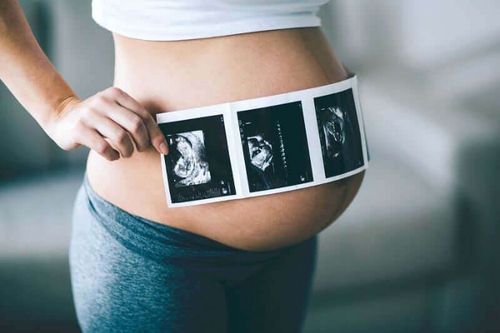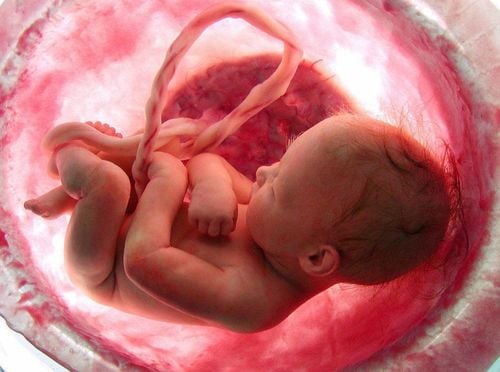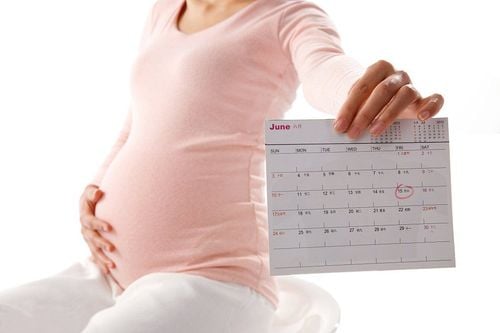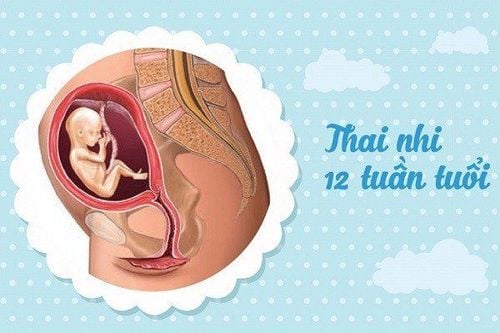This is an automatically translated article.
The article is professionally consulted by Doctor Department of Obstetrics and Gynecology, Vinmec Hai Phong International General Hospital.
During the 35th week of pregnancy (3rd trimester), the baby's body goes through many changes. At this time, the weight and length continue to grow, the skin becomes more ruddy and smooth, the baby also moves deeper into the pelvis to prepare for childbirth, the internal organs develop completely, especially The brain develops rapidly during this week of pregnancy.
1. Fetal development at 35 . weeks
35 weeks into pregnancy, or 33 weeks after conception, baby's skin becomes rosy and smooth. The baby's limbs are chubby.
Although there is not much room left in the uterus, this week, your baby's weight continues to increase at 2,378 kg. Over the next few weeks, your baby's weight continues to increase. The baby is also in a stable position and is moving lower in the mother's pelvis in preparation for birth. This movement will make the mother's breathing easier, but it will adversely affect the bladder, it will be more compressed due to the increased pressure on the bottom. Therefore, pregnant women should spend more time in clean personal hygiene care.
During week 35 of pregnancy, most of the internal organs are complete, the baby's kidneys are fully developed and the liver is already able to process some waste products. At this time, the baby's length continues to increase at about 46.3 cm.
Back to the second trimester of pregnancy when the baby's body is very small, only 2% of the body grows to an outstanding size (fat). Now that ratio has increased to 15% and at birth will double to 30% as the baby's organs gradually mature and magically fill in the gaps in the uterus.
The rate of fetal brain development continues to increase rapidly and will continue to do so throughout childhood. During this final trimester, your baby's brain weight increases by almost 10 times, and by the age of 12, that brain will be more than 3 times its size at birth.
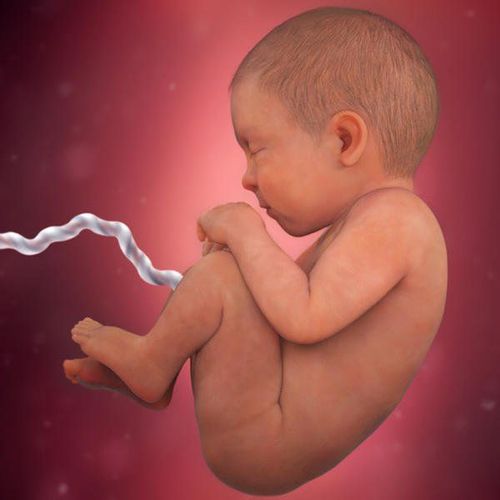
As the baby grows fuller and the limits of the mother's uterus become narrower, the kicks will increase in both frequency and force, causing pain for the mother. You may be surprised at how the diameter of your belly changes over time, it's just that your baby is changing in size.
For twins, the uterus will quickly become cramped, pregnant women will give birth earlier than those who are pregnant with one child (will give birth in the next few weeks). In fact - 37 weeks is considered a term for twins - so moms with twins should be prepared for the upcoming labor.
Details of fetal development week by week, every parent should learn:
2. New changes in the mother's body at the 35th week of pregnancy
The length from the top of the pubic bone to the top of the uterus is roughly equivalent to the number of weeks of pregnancy. So at 35 weeks pregnant, that length can reach 35cm. It's an easy way to remember how far pregnancy has come.
In the 35th week, when the fetus moves lower down the pelvis, it irritates the bladder causing problems like frequent urination & urinary incontinence.
Now that the baby is waiting to be born, the level of "disruption" increases, pressing hard on the bladder increases the need to urinate. In addition, urinary incontinence may be experienced when coughing, sneezing, or even laughing. Even if you experience the above symptoms, do not cut back on the amount of fluid (water, milk, ...) put into the body. Instead, try some methods such as emptying the urine by leaning forward (be careful of tipping over if you are pregnant with a large belly), do Kegel exercises (will strengthen the musculoskeletal system). pelvic floor and prevent or correct most incontinence cases) and wear a pair of underwear if necessary.
3. Common mother symptoms during pregnancy Week 35
Frequent headaches If headaches occur, it could be due to a number of reasons such as overheating or the feeling of being trapped in a stuffy room. Take a break and go outside for some fresh air or open a window. And ask your doctor for advice on which pain relievers are safe (in moderation) during pregnancy. Acetaminophen is a pain reliever that is considered safe for pregnant women and highly effective, as long as the pregnant woman does not overwork or overdose.
Varicose veins The veins in the legs start to hurt (or itch). The use of support hoses can help push the veins in the legs a little more to counteract the pressure from the lower abdomen.
Hemorrhoids Varicose veins can occur in the blood vessels around the rectum and cause hemorrhoids. To soothe them, wipe yourself with warm water and toilet paper. If toilet paper is still causing a lot of pain, switch to a washcloth.
Bleeding gums Pregnant women's gums can bleed. To limit bleeding, get plenty of vitamin C. Drink an extra glass of OJ, sprinkle berries on oatmeal or cereal, and serve tomatoes in salads.

Dermatitis If suddenly there is an itchy rash, a red rash on the abdomen, the pregnant woman may have PUPPP (pruritic papules - urticaria in pregnancy). To soothe the itch, try applying aloe vera gel after showering.
Slow Body balance becomes more difficult this week as you near your due date (just a few weeks away). Pregnant women should exercise safely - if you need to reach for something on a high shelf, ask a loved one instead of climbing on a chair to get it.
Pregnancy brain A woman's body is increasingly tired, forgetting things happen more often. The volume of brain cells at this time is actually shrinking and sleepiness also increases, making pregnant women more susceptible to drowsiness. The condition should improve a few months after the baby is born.
Braxton Hicks contractions Contractions increase because the woman's body is now ready for labor. First-time mothers may not notice the flexion of the uterine muscles (feeling like the abdomen is tightening).
4. Taking care of pregnant women at 35 weeks of pregnancy
Learn about pain relief during childbirth: Pregnant women can learn about pain relief options during childbirth, including local anesthetic techniques, and breathing techniques to make delivery more comfortable while remaining awake throughout the entire pregnancy to welcome the birth of the baby.
Use Nasal Strips: Pregnancy hormones cause the lining of the nose to swell, making a woman feel stuffy. Buying a box of nasal strips will help pregnant women breathe easier.
Preparing for a birth plan: Pregnant women should learn about:
All you need to know about pregnancy and delivery (labor and delivery) How the birth process unfolds - from the first contraction until your baby is born Make a birth plan. Pregnant women should also learn about reputable hospitals with doctors, nurses or midwives that best care for mother and baby.
Heartburn relief: Be sure to sit up straight while eating - and stay that way for a few hours after eating. When you have to bend, do it on your knees instead of at your waist. While you are eating, eat slowly. Chewing is the first step in digestion, but it's the most often overlooked step when eating. The more you chew, the less work your stomach has to do. Another good way to chew: Chewing sugar-free gum increases saliva, which can help neutralize acid in the esophagus. (Just don't overdo it - too much sugar-free gum can have a laxative effect thanks to the sugars in it).
Keep exercising: Babies born to women who exercised during pregnancy tend to sleep through the night earlier, have less colic and are better able to soothe themselves. Scientists think these babies are stimulated by their mothers through changes in heart rate and oxygen levels, as well as the sounds and vibrations they experience in the womb during exercise.

Attend a newborn CPR class: Pregnant women will probably never have to use this skill, but knowing how to perform CPR on a newborn is essential. There are many outside classes available, including free or low-cost options at hospitals and community health education centers. Pregnant women can also practice at home. No matter where you study, it should be completed to ensure that you can practice in the event of an unfortunate event.
During the last 3 months of pregnancy, especially from week 35 onwards, the health of both mother and baby needs to be closely monitored and checked. Pregnant women need:
Know the real signs of labor to get to the hospital in time, affecting the health of the fetus. Differentiate between amniotic fluid and vaginal discharge for timely treatment to avoid premature birth, fetal distress, and stillbirth. Be especially careful when bleeding in the last 3 months of pregnancy needs urgent emergency care to ensure the life of both mother and baby. Monitor the amount of amniotic fluid regularly and continuously. Monitor fetal weight in the last 3 months to assess baby's development and predict possible risks at birth. The special monitoring group is the same as the striker, and the fetal growth retardation needs to be closely monitored by the doctor and given appropriate indications. Distinguish between physiological contractions, labor contractions and mechanical pregnancy to get to the hospital in time. Maternity service package at Vinmec helps pregnant women's pregnancy become lighter and safer. During pregnancy, pregnant women will be examined by top doctors in the Obstetrics and Gynecology Department with high professional qualifications and experience, giving the best advice and treatment for the health of both mother and child. little.
Please dial HOTLINE for more information or register for an appointment HERE. Download MyVinmec app to make appointments faster and to manage your bookings easily.
Reference source: Webmd.com; Babycenter.com




